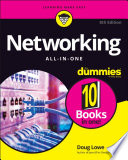

The foundation of networking lies in understanding its core concepts. Networking involves connecting computers and devices to share resources and information. This section delves into the basic components of networks, including hardware like routers, switches, and cables, as well as software protocols that govern communication. It covers the OSI model, which outlines the layers of network communication, from physical connections to application-level interactions. By grasping these fundamentals, readers can better troubleshoot issues, optimize performance, and design effective networks.
Continue readingNetworking is not a one-size-fits-all solution; rather, it encompasses various types of networks tailored for different needs. This section explores Local Area Networks (LANs), Wide Area Networks (WANs), and Metropolitan Area Networks (MANs), detailing their characteristics, advantages, and ideal use cases. The book also touches on wireless networks, including Wi-Fi standards and configurations, and how they compare to wired networks. Understanding these distinctions is crucial for selecting the right networking solution for specific environments, whether for home use, small businesses, or large enterprises.
Continue readingIn an age where cyber threats are rampant, network security is paramount. This section emphasizes the importance of securing networks against unauthorized access and data breaches. It covers fundamental security measures such as firewalls, encryption, and intrusion detection systems. The discussion extends to best practices for setting up secure networks, including user authentication, access control, and regular updates. By prioritizing security, individuals and organizations can protect sensitive information and maintain the integrity of their networks.
Continue readingNetwork issues can disrupt operations and lead to significant downtime. This section provides readers with systematic approaches to diagnosing and resolving common networking problems. It introduces tools and techniques for troubleshooting, such as ping tests, traceroute, and network monitoring software. The book highlights the importance of maintaining documentation and having a clear understanding of network topology to facilitate effective troubleshooting. By equipping readers with these skills, they can minimize downtime and enhance network reliability.
Continue readingProtocols are the rules that govern communication over networks. This section delves into various networking protocols, including TCP/IP, HTTP, FTP, and others. It explains how these protocols enable data transmission and ensure that devices can communicate effectively. Readers learn about the role of IP addressing, subnetting, and routing in network design. Understanding these protocols is essential for anyone looking to build or manage networks, as it lays the groundwork for effective data exchange and connectivity.
Continue readingAs technology evolves, so does networking. This section explores the concepts of cloud networking and virtualization, which have transformed how businesses approach IT infrastructure. It discusses the benefits of cloud services, such as scalability, cost-effectiveness, and flexibility. The book also covers virtualization technologies, including virtual private networks (VPNs) and virtual LANs (VLANs), which enhance network efficiency and security. By embracing these modern networking paradigms, organizations can optimize their operations and adapt to changing demands.
Continue readingThe networking landscape is continually evolving, influenced by advancements in technology and changing user needs. This section looks ahead to future trends, such as the Internet of Things (IoT), 5G technology, and artificial intelligence in networking. It discusses how these developments will impact network design, security, and management. By understanding these trends, readers can prepare for the future of networking and position themselves to leverage new opportunities as they arise.
Continue reading